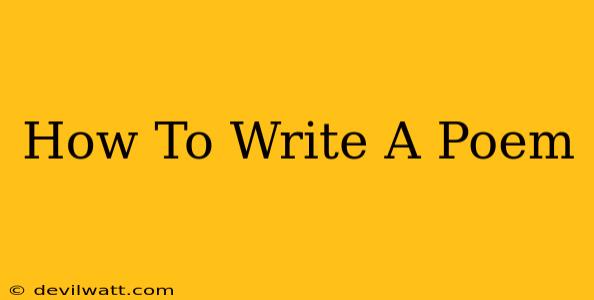So, you want to write a poem? Fantastic! Whether you're a seasoned wordsmith or just starting your poetic journey, crafting a poem can be a deeply rewarding experience. This guide will walk you through the process, offering practical tips and inspiration to help you unleash your inner poet.
Understanding the Fundamentals of Poetry
Before diving into the creative process, let's establish a basic understanding of what makes a poem a poem. While there are countless forms and styles, several core elements typically define poetry:
1. Language: Poetry utilizes language in a highly evocative and concise manner. Every word counts! Think about the sound of words, their connotations, and their power to paint vivid images in the reader's mind.
2. Imagery: Poetry relies heavily on imagery – the use of descriptive language to create mental pictures. Engage all five senses to bring your poem to life. Instead of simply saying "it was cold," describe the biting wind, the frost on the ground, the numb feeling in your fingers.
3. Figurative Language: Metaphors, similes, personification – these literary devices add depth and meaning to your poetry. They allow you to express complex ideas and emotions in a unique and memorable way.
4. Form and Structure: While free verse poems offer more freedom, many forms (sonnets, haikus, limericks) have specific rules regarding rhyme, rhythm, and line length. Experimenting with different forms can significantly enhance your poetic skills.
5. Theme and Meaning: What's the central idea or message of your poem? What emotions or experiences are you conveying? A strong theme will provide a foundation for your poetic creation.
The Poetic Process: From Idea to Finished Poem
Now that we've covered the basics, let's explore the steps involved in crafting a poem:
1. Find Your Inspiration: Where do your ideas come from? Look to your own experiences, observations of the world around you, memories, dreams, or even current events. Inspiration can strike anywhere! Keep a notebook handy to jot down interesting words, phrases, or ideas that spark your creativity.
2. Brainstorm and Freewrite: Don't censor yourself! Let your ideas flow freely onto the page. Write down everything that comes to mind, even if it seems unrelated or nonsensical. This initial brainstorming phase is crucial for generating raw material.
3. Choose a Form and Structure: Consider the type of poem you want to write. Will it be a free verse poem, a sonnet, a haiku, or something else? The chosen structure will influence your word choices and overall flow.
4. Craft Your Lines: Start shaping your ideas into poetic lines. Pay attention to rhythm, rhyme (if applicable), and the overall musicality of your language. Read your lines aloud to get a sense of their rhythm and flow.
5. Refine and Revise: Once you have a draft, don't be afraid to revise and refine your work. Read your poem aloud again, looking for areas that could be improved. Experiment with different word choices, rearrange lines, or add/remove details to enhance impact.
6. Seek Feedback: Share your poem with trusted friends, writing groups, or mentors for constructive criticism. Fresh perspectives can help you identify areas for improvement.
Tips for Aspiring Poets
- Read Widely: Immerse yourself in the world of poetry. Read poets from different eras and styles to broaden your understanding and find inspiration.
- Practice Regularly: Like any skill, writing poetry improves with practice. Set aside dedicated time for writing, even if it's just for 15 minutes a day.
- Embrace Experimentation: Don't be afraid to try new things. Experiment with different forms, styles, and techniques to discover your unique poetic voice.
- Find Your Community: Connect with other poets through workshops, online forums, or writing groups to share your work and get feedback.
Writing a poem is a journey of self-discovery and creative expression. By following these steps, and with consistent practice, you can develop your skills and unlock your potential as a poet. So grab your pen (or keyboard!), find your inspiration, and let your creativity flow!

